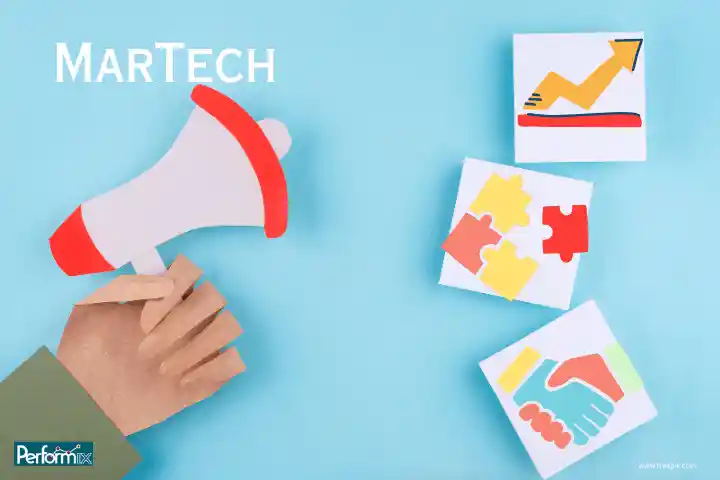Marketing technology, or martech, uses software and tools to optimize and automate marketing activities. Martech can help you attract, engage, and retain customers across various channels and platforms. But how do you choose the right Martech solutions for your business? And how do you integrate them into a cohesive and effective martech stack? In this blog post, these questions will be answered.
What is a Martech Stack?
A martech stack is the collection of technologies and software you use to execute and manage your marketing campaigns and tactics. A martech stack can include different types of tools, such as:
- Email marketing platforms like Mailchimp or Constant Contact
- Social media management platforms like Hootsuite or Sprout Social
- Marketing automation platforms like HubSpot or Marketo
- Customer relationship management (CRM) software like Salesforce or Zoho CRM
- Analytics tools to track the success of marketing efforts like Google Analytics or Adobe Analytics
- Content management systems (CMS) that host a company blog like WordPress or Ghost
- And many more
A martech stack can vary depending on your business goals, budget, and industry. However, the primary purpose of a martech stack is to help you streamline and optimize your marketing processes, improve your customer experience, and measure your marketing performance.
How to Build a Martech Stack?
Building a martech stack can seem daunting, but it doesn’t have to be. Here are some steps to help you build a martech stack that suits your needs and grows with you:
- Start with your goals:
Before investing in any martech tool, you must define your marketing goals and objectives. What are you trying to achieve with your marketing? Who are you trying to reach? How will you measure your success? Having clear and specific goals will help you narrow down your options and focus on the tools to help you achieve them.
- Assess your current situation:
Next, you must evaluate your current Martech stack if you have one. What tools are you already using? What are their strengths and weaknesses? How well are they integrated? How much are you spending on them? Are they helping you reach your goals or hindering your progress? By analyzing your current scenario, you can pinpoint the gaps and opportunities within your martech stack and make informed decisions about what to retain, replace, and incorporate.
- Research and compare:
Once you have a clear idea of what you need and don’t need, you can start researching and comparing different Martech solutions. You can utilize online resources like reviews, case studies, demos, and free trials to gain deeper insights into each tool’s features, benefits, and costs. You can also ask for recommendations from your peers, industry experts, or consultants. The key is finding the tools that match your goals, budget, and requirements, which can work well together.
- Implement and integrate:
After selecting your martech tools, you need to implement and integrate them into your martech stack, which may require some technical assistance, depending on the complexity and compatibility of the tools. You may also need to train your team to use the new tools and follow the best practices. The goal is to ensure that your Martech stack functions smoothly and efficiently and that your team is comfortable and confident.
- Monitor and optimize:
Ultimately, it’s crucial to monitor and refine your martech stack consistently. This involves tracking the performance and effectiveness of each tool and the stack, utilizing metrics and KPIs aligned with your objectives. You must also update and upgrade your tools to meet the changing market and customer expectations. The goal is to ensure that your martech stack delivers the best results and value for your business.

Examples of Martech Stacks
To give you some inspiration, here are some examples of martech stacks from different businesses and industries:
- Shopify, an e-commerce platform, uses a martech stack that includes tools like Google Analytics, Google Ads, Facebook Ads, Mailchimp, Zendesk, and Shopify to drive traffic, conversions, and customer loyalty.
- Netflix, a streaming service, uses a martech stack that includes tools like Amazon Web Services, Google Cloud Platform, Snowflake, Tableau, Braze, and Optimizely to store, analyze, and personalize data and to run experiments and campaigns.
- HubSpot, a marketing software company, uses a martech stack that includes tools like HubSpot, WordPress, Google Analytics, Google Ads, LinkedIn Ads, Drift, and Vidyard to create, distribute, and optimize content and to generate and nurture leads.
The Importance of Marketing Technology in the USA and Worldwide Market
Marketing technology, or martech, is not a buzzword but a necessity for every business that wants to stay competitive and relevant in the digital age. Martech can help companies improve their marketing efficiency, effectiveness, and customer satisfaction by leveraging data, automation, personalization, and innovation.
According to Statista, the global martech market was valued at nearly 670 billion U.S. dollars in 2023 and is expected to grow at a compound annual growth rate (CAGR) of 19.8% from 2023 to 2030. In the USA, the business-to-business (B2B) subsegment alone spent more than 7.5 billion dollars on martech throughout 2023. Moreover, the number of martech solutions available worldwide increased from 150 in 2011 to over 8,000 in 2023, indicating the diversity and dynamism of the martech landscape.
The importance of martech is also reflected in businesses’ marketing budgets and strategies. A survey by Gartner found that the share of marketing budgets in North America and Europe increased from 22% in 2017 to 29% in 2023, with martech accounting for 26% of the total marketing budget in 2023. Furthermore, a report by Mirum India revealed that 72% of Indian marketers planned to increase their martech spending in 2023, and 62% considered martech a key driver of business growth.
Martech enables businesses to accomplish diverse marketing objectives, including boosting brand visibility, generating leads, converting prospects, retaining customers, and fostering loyalty.

Are you curious about how Generative AI can transform our learning in 2024 and beyond? Listen Now to the Expert’s Vision on Spotify.
Benefits of Martech include:
- Data-driven decision-making:
Martech can help businesses collect, analyze, and act on customer data, such as preferences, behavior, feedback, and satisfaction, assisting companies in understanding their customers better, segmenting them into relevant groups, and tailoring their marketing messages and offers accordingly.
- Automation and efficiency:
Martech allows businesses to automate and streamline marketing tasks like email marketing, social media management, content creation, and campaign management. This efficiency enables companies to conserve time, money, and resources, allowing them to prioritize strategic and creative endeavors.
- Personalization and engagement:
Martech can help businesses deliver personalized and relevant customer experiences across channels and platforms. This can help companies increase customer engagement, trust, and loyalty and reduce churn and attrition.
- Innovation and differentiation:
Martech can help businesses leverage emerging technologies like artificial intelligence, augmented reality, and chatbots to create innovative and differentiated marketing solutions. This can help companies stand out, attract new customers, and retain existing ones.
Conclusion
Martech is a powerful and essential component of modern marketing. By building a martech stack that suits your needs and goals, you can streamline and automate your marketing processes, improve your customer experience, and measure your marketing performance. However, building a martech stack can be challenging and time-consuming, especially for small and medium-sized enterprises.
That’s why Performix Business Services LLC is here to help you with your martech needs.
Contact Performix today and let them help you build a martech stack that will take your marketing to the next level.
Blog Summary:
Martech (marketing technology) is crucial for businesses to stay competitive!
Businesses use marketing technology (martech) to attract, engage, and retain customers through various tools like email marketing and social media management. Building a martech stack involves defining goals, researching solutions, and integrating them to improve efficiency, personalize experiences, and make data-driven decisions.






